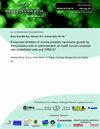Didymin protects against polystyrene nanoplastic-induced hepatic damage in male albino rats by modulation of Nrf-2/Keap-1 pathway
IF 1.9
4区 医学
Q2 BIOLOGY
Brazilian Journal of Medical and Biological Research
Pub Date : 2024-01-22
DOI:10.1590/1414-431X2023e13173
引用次数: 0
Abstract
Polystyrene nanoplastics (PS-NPs) are ubiquitous environmental pollutants that can cause oxidative stress in various organs, including the liver. Didymin is a dietary flavanone that displays multiple pharmacological activities. Therefore, the present study evaluated the palliative role of didymin against PS-NPs-induced hepatic damage in rats. Albino rats (n=48) were randomly distributed into 4 groups: control, PS-NPs treated group, PS-NPs + didymin co-administered group, and didymin supplemented group. After 30 days, PS-NPs intoxication lowered the expression of Nrf-2 and anti-oxidant genes [catalase (CAT), superoxide dismutase (SOD), glutathione peroxidase (GPx), glutathione reductase (GSR), glutathione-S-transferase (GST), and heme oxygenase-1 (HO-1)], whereas the expression of KEAP1 kelch like ECH associated protein 1 (Keap-1) was increased. PS-NPs exposure also reduced the activities of anti-oxidants enzymes (CAT, SOD, GPx, GSR, GST, GSH, and OH-1), while malondialdehyde (MDA) and reactive oxygen species (ROS) levels were increased. The levels of alanine transaminase (ALT), aspartate aminotransferase (AST), and alkaline phosphatase (ALP) were increased in PS-NPs-exposed rats. Moreover, inflammatory indices [interleukin-1β (IL-1β), tumor necrosis factor alpha (TNF-α), interleukin-6 (IL-6), nuclear factor-kappa B (NF-κB), and cyclooxygenase-2 (COX-2)] were increased in PS-NPs-exposed rats. Furthermore, PS-NPs intoxication increased the expressions of apoptotic markers including Bax and Caspase-3, as well as reducing Bcl-2 expression. The histopathological analysis showed significant damage in PS-NPs-treated rats. However, didymin supplementation ameliorated all the PS-NPs-induced damage in the liver of rats. Therefore, it was concluded that didymin can act as a remedy against PS-NPs-induced liver toxicity due to its anti-apoptotic, anti-oxidant, and anti-inflammatory activities.地迪明通过调节 Nrf-2/Keap-1 通路保护雄性白化大鼠免受聚苯乙烯纳米塑料诱发的肝损伤
聚苯乙烯纳米塑料(PS-NPs)是一种无处不在的环境污染物,可对包括肝脏在内的多个器官造成氧化应激。Didymin是一种膳食黄酮,具有多种药理活性。因此,本研究评估了地迪明对 PS-NPs 引起的大鼠肝损伤的缓解作用。将白化大鼠(n=48)随机分为 4 组:对照组、PS-NPs 处理组、PS-NPs + 稻瘟灵合用组和补充稻瘟灵组。30天后,PS-NPs中毒降低了Nrf-2和抗氧化基因[过氧化氢酶(CAT)、超氧化物歧化酶(SOD)、谷胱甘肽过氧化物酶(GPx)、谷胱甘肽还原酶(GSR)、谷胱甘肽-S-转移酶(GST)和血红素加氧酶-1(HO-1)]的表达,而KEAP1 kelch like ECH associated protein 1(Keap-1)的表达增加。接触 PS-NPs 还降低了抗氧化酶(CAT、SOD、GPx、GSR、GST、GSH 和 OH-1)的活性,同时丙二醛(MDA)和活性氧(ROS)水平升高。暴露于 PS-NPs 的大鼠体内的丙氨酸转氨酶(ALT)、天门冬氨酸转氨酶(AST)和碱性磷酸酶(ALP)水平均有所升高。此外,PS-NPs 暴露大鼠的炎症指数[白细胞介素-1β(IL-1β)、肿瘤坏死因子α(TNF-α)、白细胞介素-6(IL-6)、核因子-Kappa B(NF-κB)和环氧化酶-2(COX-2)]也有所增加。此外,PS-NPs 中毒增加了包括 Bax 和 Caspase-3 在内的凋亡标志物的表达,同时降低了 Bcl-2 的表达。组织病理学分析表明,PS-NPs 对大鼠造成了明显的损伤。然而,补充地迪明后,大鼠肝脏中所有由 PS-NPs 引起的损伤都得到了改善。因此,可以得出结论:由于具有抗细胞凋亡、抗氧化和抗炎活性,didymin 可以作为一种治疗 PS-NPs 引起的肝脏毒性的药物。
本文章由计算机程序翻译,如有差异,请以英文原文为准。
求助全文
约1分钟内获得全文
求助全文
来源期刊
CiteScore
4.00
自引率
0.00%
发文量
129
审稿时长
2 months
期刊介绍:
The Brazilian Journal of Medical and Biological Research, founded by Michel Jamra, is edited and published monthly by the Associação Brasileira de Divulgação Científica (ABDC), a federation of Brazilian scientific societies:
- Sociedade Brasileira de Biofísica (SBBf)
- Sociedade Brasileira de Farmacologia e Terapêutica Experimental (SBFTE)
- Sociedade Brasileira de Fisiologia (SBFis)
- Sociedade Brasileira de Imunologia (SBI)
- Sociedade Brasileira de Investigação Clínica (SBIC)
- Sociedade Brasileira de Neurociências e Comportamento (SBNeC).

 求助内容:
求助内容: 应助结果提醒方式:
应助结果提醒方式:


